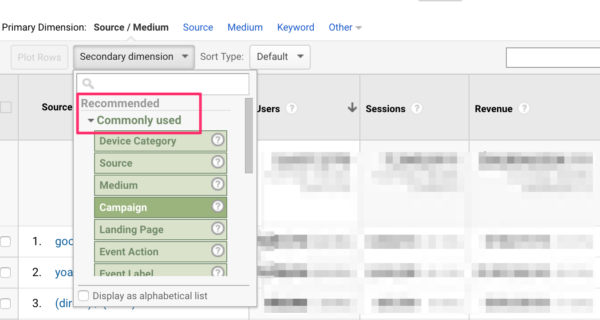From Data to Strategy: Just How Secondary Dimensions Boost Your Search Engine Optimization Initiatives
From Data to Strategy: Just How Secondary Dimensions Boost Your Search Engine Optimization Initiatives
Blog Article
Transform Your Information Comprehending With Additional Dimensions
Checking out data through the lens of second dimensions opens up a realm of untapped understandings, supplying an extra nuanced point of view on the ins and outs of your dataset. By deciphering the layers underneath the surface metrics, you can discover patterns and connections that may have otherwise gone unnoticed, leading the method for informed decision-making and strategic optimizations. This critical application of additional dimensions not just enhances your information understanding but also functions as a driver for unlocking the complete potential of your analytics undertakings.
Advantages of Additional Dimensions

By layering extra measurements onto existing information, companies can analyze the influence of different aspects on crucial metrics, aiding them make more educated decisions. Overall, the utilization of second measurements leads to a lot more insightful and durable data analysis, encouraging services to drive calculated actions based on a much deeper understanding of their information.

Exactly How to Apply Second Dimensions
To successfully implement additional dimensions in data analysis, services ought to first determine vital variables that straighten with their logical objectives and goals. It is vital to take into consideration just how these second measurements will provide added context and deepness to the main data being analyzed.

Analyzing Information With Additional Dimensions
Utilizing secondary measurements in data evaluation boosts the deepness and context of insights derived from key information. By incorporating secondary measurements into your analysis, you can obtain a much more detailed understanding of the connections and patterns within your data. This procedure entails checking out the main data via different lenses or perspectives, which can disclose concealed correlations or trends that might not be immediately evident when evaluating the information making use of just primary measurements.
Evaluating information with secondary measurements allows you to segment and team your data in numerous methods, providing a much more nuanced view of your dataset. secondary dimensions. This segmentation can assist you determine details factors that might be influencing the results you are examining. By piercing down right into the data utilizing second dimensions, you can discover important understandings that can guide decision-making and method development
Finest Practices for Second Dimensions
When including secondary measurements right into data analysis, accuracy in specifying the dimensions is vital for extracting significant understandings. It about his is important to pick secondary dimensions that enhance the primary information successfully. One ideal practice is to choose measurements that give additional context without overwhelming the analysis. Maintain in mind the details goals of the analysis and select measurements that align with those objectives.
Another best practice is to prevent redundancy in dimensions. Make certain that the second measurements include brand-new viewpoints or details to the evaluation, as opposed to duplicating info already present in the primary dimensions. This will certainly assist protect against confusion and streamline the interpretation of the information.
In addition, it is necessary to consider the scalability of the analysis when choosing secondary dimensions. Pick measurements that can be quickly expanded or readjusted as required to suit future data requirements or modifications in logical focus. By complying with these finest practices, analysts can make the most of the value of secondary measurements in data analysis and gain much deeper understandings into their datasets.
Maximizing Insights Via Secondary Measurements
Integrating additional dimensions tactically enhances data analysis by supplying a deeper understanding of the partnerships within the dataset (secondary dimensions). By making the most of insights via additional dimensions, analysts can uncover beneficial patterns, fads, and dependencies that might not be right away apparent when anchor taking a look at the data through key measurements alone
One key benefit of utilizing additional dimensions is the ability to section and filter information a lot more precisely. This segmentation allows for a much more granular analysis of certain parts within the dataset, making it possible for analysts to recognize correlations and causations that may have otherwise been forgotten.
Additionally, second dimensions can assist in contextualizing key data factors by including layers of info that supply a more extensive sight of the information. This contextualization is important for making educated decisions based on an alternative understanding of the dataset.
Verdict
To conclude, integrating second dimensions in data analysis procedures supplies a more nuanced and thorough understanding of details, leading to improved understandings and critical decision-making. By incorporating additional variables that align with analytical goals, hidden relationships and patterns can be exposed, giving an extra detailed and contextualized view of data. This strategy makes the most of the possibility for optimization and discovers brand-new chances within procedures.
On the whole, the utilization of additional dimensions leads to extra durable and insightful information evaluation, encouraging organizations to drive critical activities based on a much deeper understanding of their data.
Using secondary measurements in information evaluation improves the depth and context of insights acquired from main data.Analyzing data with second measurements enables you to section and group your information in numerous methods, giving a more nuanced view of your dataset.When incorporating second his response measurements into information evaluation, precision in specifying the measurements is vital for drawing out meaningful understandings. Make sure that the secondary measurements include new perspectives or information to the analysis, instead than duplicating info currently present in the key dimensions.
Report this page